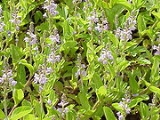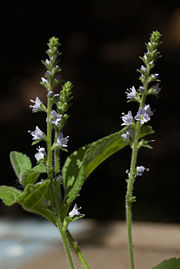
Veronica officinalis
Encyclopedia

Veronica (plant)
Veronica is the largest genus in the flowering plant family Plantaginaceae, with about 500 species; it was formerly classified in the family Scrophulariaceae...
, native to Europe
Europe
Europe is, by convention, one of the world's seven continents. Comprising the westernmost peninsula of Eurasia, Europe is generally 'divided' from Asia to its east by the watershed divides of the Ural and Caucasus Mountains, the Ural River, the Caspian and Black Seas, and the waterways connecting...
and western Asia
Asia
Asia is the world's largest and most populous continent, located primarily in the eastern and northern hemispheres. It covers 8.7% of the Earth's total surface area and with approximately 3.879 billion people, it hosts 60% of the world's current human population...
.
It is a herbaceous
Herbaceous
A herbaceous plant is a plant that has leaves and stems that die down at the end of the growing season to the soil level. They have no persistent woody stem above ground...
perennial
Perennial plant
A perennial plant or simply perennial is a plant that lives for more than two years. The term is often used to differentiate a plant from shorter lived annuals and biennials. The term is sometimes misused by commercial gardeners or horticulturalists to describe only herbaceous perennials...
with hairy green stems 10–50 cm long that cover the ground in mats and send up short vertical shoots which bear soft violet flowers. The leaves
Leaf
A leaf is an organ of a vascular plant, as defined in botanical terms, and in particular in plant morphology. Foliage is a mass noun that refers to leaves as a feature of plants....
are 1.5–5 cm long and 1–3 cm broad, and softly hairy.
It flowers from May until August.
Cultivation and uses
This speedwell grows in fields and takes hold in areas that have been disturbed. It is a potential weedWeed
A weed in a general sense is a plant that is considered by the user of the term to be a nuisance, and normally applied to unwanted plants in human-controlled settings, especially farm fields and gardens, but also lawns, parks, woods, and other areas. More specifically, the term is often used to...
if its seed gets into collections of agricultural
Agriculture
Agriculture is the cultivation of animals, plants, fungi and other life forms for food, fiber, and other products used to sustain life. Agriculture was the key implement in the rise of sedentary human civilization, whereby farming of domesticated species created food surpluses that nurtured the...
seed, such as alfalfa
Alfalfa
Alfalfa is a flowering plant in the pea family Fabaceae cultivated as an important forage crop in the US, Canada, Argentina, France, Australia, the Middle East, South Africa, and many other countries. It is known as lucerne in the UK, France, Australia, South Africa and New Zealand, and known as...
. Historically the green parts of the plant have been used medicinally
Herbalism
Herbalism is a traditional medicinal or folk medicine practice based on the use of plants and plant extracts. Herbalism is also known as botanical medicine, medical herbalism, herbal medicine, herbology, herblore, and phytotherapy...
for coughs, otitis media
Otitis media
Otitis media is inflammation of the middle ear, or a middle ear infection.It occurs in the area between the tympanic membrane and the inner ear, including a duct known as the eustachian tube. It is one of the two categories of ear inflammation that can underlie what is commonly called an earache,...
, and gastrointestinal distress. The plant is rich in vitamins, tannin
Tannin
A tannin is an astringent, bitter plant polyphenolic compound that binds to and precipitates proteins and various other organic compounds including amino acids and alkaloids.The term tannin refers to the use of...
s, and the glycoside
Glycoside
In chemistry, a glycoside is a molecule in which a sugar is bound to a non-carbohydrate moiety, usually a small organic molecule. Glycosides play numerous important roles in living organisms. Many plants store chemicals in the form of inactive glycosides. These can be activated by enzyme...
aucuboside. Aucuboside, which is also found in many other Plantaginaceae
Plantaginaceae
Plantaginaceae Juss. or plantain family, are a family of flowering plants in the order Lamiales. The type genus is Plantago L..In older classifications it used to be the only family of the order Plantaginales, but numerous phylogenetic studies, summarized by the Angiosperm Phylogeny Group, have...
species, is thought to have anti-inflammatory properties. Extracts are widely sold as herbal remedies for sinus
Paranasal sinus
Paranasal sinuses are a group of four paired air-filled spaces that surround the nasal cavity , above and between the eyes , and behind the ethmoids...
and ear infections. It has been introduced to North America and is widely naturalised
Naturalisation (biology)
In biology, naturalisation is any process by which a non-native organism spreads into the wild and its reproduction is sufficient to maintain its population. Such populations are said to be naturalised....
there.
The slightly bitter and astringent taste and tea-like smell of speedwell led to its use as a tea substitute in 19th-century France, where it was called the d'Europe, or "Europe tea." The French still use this term as a name for speedwell.
External links
- Skye Flora
- http://books.google.com/books?id=1kFBAAAAcAAJ&pg=PA132&lpg=PA132&dq=%22thee+d'europe%22+veronica&source=bl&ots=vc3o6ZcvRk&sig=R37WcT1IE7loUB1YOw5PbQH_3TU&hl=en&ei=bEyQTt2QEsrm4QSUn72WAQ&sa=X&oi=book_result&ct=result&resnum=1&sqi=2&ved=0CBkQ6AEwAA#v=onepage&q=%22thee%20d'europe%22%20veronica&f=false

